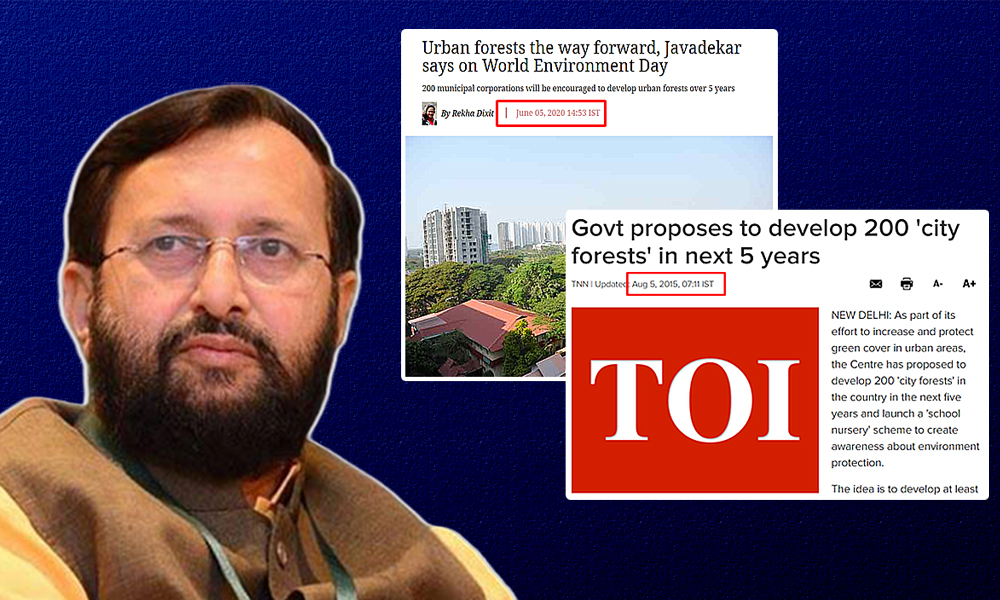
Image Credits: The Time Of India, The Week, vijaykarnataka
Five Years Later, Govt Relaunches Programme To Develop 200 'City Forests' In The Country
India, 7 Jun 2020 3:56 AM GMT | Updated 7 Jun 2020 3:57 AM GMT
Editor : Shubhendu Deshmukh |
Shubhendu, the quint essential news junky, the man who loves science and politics in equal measure and offers the complete contrast to it by being a fan of urdu poetry as well.
Creatives : Nandan M
Creative designer Skilled in Photography, Graphics, Typography, Animation, and Editing. Strong arts and design professional with a diploma focused on adobe suit.
Union Environment Minister Prakash Javadekar launched the Nagar Van or Urban Forests with 200 corporations and cities across the country during the virtual celebration of World Environment Day 2020, themed as 'Nature and Biodiversity'.
Five years ago, in 2015, the Centre had proposed to develop 200 'city forests' in the country in the next five years, as part of its effort to increase and protect green cover in urban areas.
The idea was to have at least one 'city forest' initially on forest land in cities having municipal corporations, ranging from 20 hectare to 100 hectares.
"The environment ministry will provide one time financial support for development of these city forests", Union environment and forests minister Prakash Javadekar had said.
"The scheme aims to create 200 city forests in the country in the next five years", the minister had said.
On World Environment Day in 2016 again, the government launched the 'Urban Forestry Scheme' in as many as 200 cities and towns across India. 6,000 saplings were planned to be planted in Pune to create an 'urban jungle' on about 80 acres of land.
"There are many cities where the forest department has its and but there are no forest on it or degraded. In these places through people's participation, we will establish urban forestry," Javadekar had said in 2016.
At an event to mark World Environment Day virtually due to the COVID-19 pandemic on Friday, June 5, Union Environment Minister Prakash Javadekar said that there is a need to increase forest cover in urban areas to enhance their lung capacities.
Javadekar launched the Nagar Van or Urban Forests with 200 corporations and cities across the country during the virtual celebration of World Environment Day 2020, themed as 'Nature and Biodiversity'. He urged people to participate and try to increase the tree cover in their areas.
"Our lifestyle is with nature. Rural areas have forests but urban areas don't have as much. We have decided to launch today the Nagar Van programme with 200 corporations," The Hindu quoted the minister as saying.
"Urban forests will work as urban lungs. I appeal to people to work together and make it a people's movement. We will reward people who participate and make it a success. Plant trees and increase their number as they are oxygen tanks," he added.
What Are City Forests?
An urban or city forest is a forest, or a collection of trees, that grow within a city, suburb or town. It could include any woody plant vegetation growing in and around human settlements.
Care and management of urban forests, which can be privately and publicly owned, is called urban forestry. Some municipal forests could even be located outside of the town or city which they belong to.
Besides beautification of the urban environment, city forests offer benefits like impacting climate and the economy while providing shelter to wildlife and recreational area for city dwellers.
What The Data Shows
Forest cover includes all patches of land with over 10% tree canopy density over one hectare in area, irrespective of the species of trees, land use and ownership. Therefore, if the area of an orchard is less than one hectare, that too would be classified as a forest.
Convention on Biological Diversity says that a forest includes only areas "not primarily under agricultural or other specific non-forest land use."
The Logical Indian, upon searching government websites, could not find relevant data to prove that the government has attained its goal of '200 city forests' between 2015 and 2020.
A recent report published by Global Forest Watch said that the annual forest loss in the year 2016 was 3,310 hectares, followed by 3,060 hectares in 2017 and 3,537 hectares in 2018. The numbers have soared up drastically, as it has generally remained below 3,000 hectares, except in 2007, when it was 4,145 hectares.
The report was released by Global Forest Watch, a subsidiary of the World Resources Institute (WRI), a US-based NGO, which publishes reports on the basis of NASA satellite images. However, they have not provided any clarification for the Forest loss as of now, as they require more time to analyse the raw data.
Analysing the data at micro level, the Dakshin Kannada and Udupi districts are severely affected and have seen the maximum decline in the last three years. In Dakshin Kannada district, the loss was 1,072 hectares in 2018, 955 hectares in 2017 and 1,109 hectares in 2016, whereas in Udupi district the forest loss figures were 665 hectares, 857 hectares and 740 hectares respectively.
Karnataka is not the only state which has shown sharp decline in forest cover. Kerala, too, saw large scale forest disappearance during the same period. The forest loss in the Kerala was 7,187 hectares in 2016, 9,722 hectares in 2017 and 6,273 hectares in 2018.
Such a high rate has not been witnessed in Malabar state since 2011. The combined loss of Karnataka and Kerala sum up to 30,000 hectares of forests in the last three years. In contrast, the losses in Andhra Pradesh, Tamil Nadu, Maharashtra, Telangana, and Goa are comparatively low.
Meanwhile the WRI mentioned a few key points that need to be considered in order to avoid any misinterpretation of the data. For example, 'tree cover' indicates all vegetation which has a height greater than five meters, that may form any natural forests or plantations across a range of canopy densities. 'Loss' indicates destroying or mortality of tree cover, which can happen due to a variety of factors, including mechanical harvesting, fire, storm damage or disease.
The northeast of India, which once had a huge forest cover, has now been under constant threat of forest degradation. The tree cover over the last 18 years has constantly declined and the annual loss has been doubled in the last five years.
The forest loss in the Northeast is way more than what it is in the rest of the country. In general, a state loses between 15,000-30,000 hectares of forests every year, while Mizoram alone in 2017 recorded a forest loss of 41,000 hectares.
This alarming loss was also flagged in the last State of Forest report released in February 2018 by the Ministry of Environment and Forest.
As per the WRI report, India suffered a loss of more than 1,20,000 hectares in primary forestry within the last five years, which is around 36% more than such losses seen between 2009 and 2013.
Public's memory is short-lived. We tend to forget what the government promised five years back, and are more keen on focusing on what it has to offer today. It is essential for the government to update us on the attainment of their goals before launching new programmes, and in this case, the same programme that was launched in 2015.
Also Read: While India Focused On COVID-19, Here's What Govt Did To The Environment
 All section
All section














